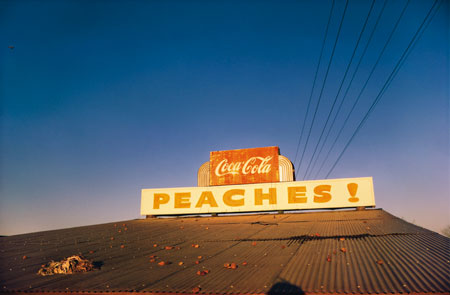MARCH 13, 2012
By Conor Risch

“Untitled, 1973,” was one of 36 photographs sold at a Christie’s auction of new William Eggleston prints.
At a Christie’s auction yesterday that was intended to expand the appeal of William Eggleston’s work to a much broader range of contemporary art collectors, 36 recent prints by the photographer brought in a total of $5,903,250.
It was the first time Eggleston created digital pigment prints, a departure from the dye-transfer process he has used since the 1970s, which offered Eggleston a deep color saturation that became a defining characteristic of his work.
The high lot in the sale, a print of Eggleston?s classic ?Untitled, 1970,? which depicts a child?s tricycle from a glorifying ground-level angle, brought in $578,500, more than doubling the previous auction record for the artist of $275,000. Several other prints sold for hundreds of thousands of dollars. The auction, “Photographic Masterworks by William Eggleston,” was a benefit for the Eggleston Artistic Trust.
According to Joshua Holdeman, international director of the Christie?s photography department, the point of the sale was to establish a new market for Eggleston?s photography in the contemporary art world. ?Eggleston has been kind of stuck in the old school world of the photography collectors for a long time, whose primary concerns are about process, print type, print date, etcetera,? says Holdeman.
Whereas the type of print and the exact date a print was made is ?a huge deal? for photography collectors, Holdeman says, “for contemporary art collectors it?s much more about the object itself?they couldn?t care if it?s a dye transfer or a pigment print or whatever, as long as the object itself is totally amazing, that?s what they care about.?
?This is an attempt to start a migration of Eggleston from the quote unquote confines of the photography world into the larger context of the art world,? Holdeman adds. By his account, the market-making auction was a stunning success. ?I think it was probably the most important event for Eggleston in a long, long time,? he says.
A print of Eggleston?s photograph ?Untitled, 1973,? which shows a corrugated metal roof sloping up to a store?s sign advertising Peaches and Coca-Cola, brought in the second highest price of the auction at $422,500. The high estimate for a smaller sized, vintage dye-transfer print of the same photograph that will be auctioned during the April 5 general photographs sale at Christie’s is $90,000. Many of the other Eggleston dye-transfers for sale in that auction have high estimates below $10,000.
The pigment prints in yesterday’s sale were from editions of two at a size of 44 x 60 inches. Eggleston had always wanted to print at a larger scale, Holdeman explains, but was confined by the size limitations of the dye-transfer process. ?A huge amount of investigation and research was done into trying to figure out a way to print his images in this larger scale that would allow for the same kind of color saturation as well as clarity [that was achieved with the dye-transfer process].?
A dozen of the photographs sold yesterday had never before been published or offered for sale, which also added to the allure of the auction. ?While there were certain iconic images that were from the Guide [William Eggleston?s Guide, the catalogue to the first-ever exhibition of color photographs at MoMA 1976] that everyone knew, there was a very conscious attempt not to make this a rehashing of the Guide in a new, larger size,? Holdeman notes.
The agreement between the Eggleston Artistic Trust and Christie?s also stipulated that the second print in the edition would not be sold for three years. ?It was very much a conscious message that we wanted to send into the world,? Holdeman says, ?that if you wanted to acquire one of these prints at anytime in the near future it?s going to be now.?





Leave a Reply
You must be logged in to post a comment.